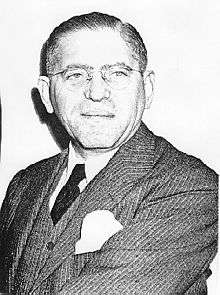Irving H. Saypol
Irving Howard Saypol (September 3, 1905 – June 30, 1977) was a United States attorney for the Southern District of New York and New York Supreme Court Justice. He was involved in several high-profile Communist prosecutions, including the Alger Hiss, William Remington, Abraham Brothman, and Julius and Ethel Rosenberg cases.[1][2]
Irving Howard Saypol | |
|---|---|
 | |
| New York Supreme Court Justice | |
| In office 1952–1968 | |
| United States Attorney for the Southern District of New York | |
| In office 1949–1951 | |
| Preceded by | John F. X. McGohey |
| Succeeded by | Myles J. Lane |
| Personal details | |
| Born | September 3, 1905 Lower East Side Manhattan, New York City |
| Died | June 30, 1977 (aged 71) Manhattan, New York City |
| Spouse(s) | Adele D. Kaplan |
| Education | St. Lawrence University Brooklyn Law School |
Biography
He was born to a Jewish family on September 3, 1905, on the Lower East Side of Manhattan, New York City to Louis and Michakin Saypol.[1][2][3]
While attending night classes at Brooklyn Law School, from which he graduated in 1927, he married Adele B. Kaplan in September 1925.[1][2] Their son, Ronald Saypol, served as CEO of Lionel Corporation from 1968 to 1982.[4] He was admitted to the bar in 1928.[5][6]
Saypol quickly advanced in the United States Attorney's Office. He became the United States Attorney for the Southern District of New York.[7] Irving Saypol led the prosecution of several members of the Communist Party of the United States (CPUSA) including Eugene Dennis, William Z. Foster, John Gates, Robert G. Thompson, Gus Hall, William Remington, Abraham Brothman and Miriam Moskowitz. As a result of these prosecutions Saypol was described by Time as "the nation's number one legal hunter of top communists."[8]
From 1950 to 1951 he was Chief Prosecutor for the federal government in the espionage case against Julius and Ethel Rosenberg and Morton Sobell.[9] He gained a reputation as an efficient prosecutor of Communists. Saypol served on the New York Supreme Court from 1952 until 1968. In 1976 he was indicted with Surrogate S. Samuel DiFalco for bribery and perjury in connection with an alleged scheme to obtain appraisal and auction commission funds for Saypol's son; the charges were dismissed.[1]
In 1975 Saypol ruled against the landmark designation for Grand Central Terminal in New York City removing legal barriers to the construction of a 59-story office tower on top of the terminal.[10]
Saypol died from cancer on June 30, 1977 at his home at 152 East 94th Street in Manhattan, New York City.[1]
References
- Tom Goldstein (July 1, 1977). "Justice Irving H. Saypol, 71, Dies; Rosenberg Spy‐Trial Prosecutor". New York Times.
- "A Stickler for Decorum – Irving Howard Saypol". New York Times. January 7, 1965. p. 23. Retrieved 4 March 2018.
- Radosh, Ronald (March 29, 2011). "Cold Case: Ethel and Julius Rosenberg". The Tablet.
The Rosenberg case was a family affair—almost everyone involved was Jewish: the Rosenbergs and the Greenglasses, those who became government witnesses against the two couples, as well as the prosecutors, Myles Lane, Irving Saypol, and Roy Cohn, and the justice who presided at the trial, Irving Kaufman
- "Ronald Saypol dies at 85; led model-train maker Lionel into retailing". Los Angeles Times. December 8, 2014.
- Caute, David (1978). The Great Fear: Anti-Communist Purge under Truman and Eisenhower. New York: Simon & Schuster. p. 63. ISBN 0-671-22682-7.
- "Saypol Appointed U.S. Attorney Here". New York Times. Associated Press. January 7, 1950.
- Gildberger, Paul (1975-01-22). "Grand Central Landmark Status Voided". The New York Times. ISSN 0362-4331. Retrieved 2017-07-05.